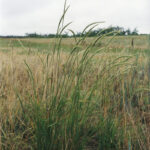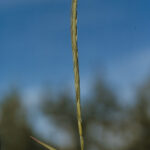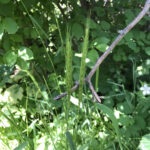Awned Wheatgrass
Elymus trachycaulus ssp. subsecundus
General Description
Awned wheatgrass is a cool season, native perennial bunchgrass. Its roots are fibrous, sometimes with short rhizomes. Awned wheatgrass is now considered a subspecies of slender wheatgrass. Awned wheatgrass has hairy sheaths on the stem and long straight awns on seed heads. Leaves are flat and medium green in color.
Type
Native grass.
Origin
Native to the prairie parkland and isolated moist areas.
Longevity
Long-lived in native stands. Longevity likely promoted by seed drop.
Use
Reclamation, pasture.
Optimal Time of Use
Awned wheatgrass is optimally grazed prior to seed head development.
Recovery After Use
Graze awned wheatgrass once per year. At least four inches (100mm) of stubble should be left after grazing to maintain vigor.
Palatability/Nutritional Value
Awned wheatgrass is palatable until heading. Awn development and coarse stems at maturity reduce palatability. Digestibility ranges from 55% in June to 35% in October and crude protein ranges from 14% in June to 4% in October.
Annual Precipitation min/max (mm)
350mm / 600mm or higher.
Drought Tolerance
Moderate drought tolerance.
Flooding Tolerance
Withstands approximately one to two weeks of spring flooding.
Winter Hardiness
Good winter hardiness.
Soil Texture Preference
Awned wheatgrass is best suited to moist, well drained loamy textured soils in sheltered areas. Awned wheatgrass is found native in moist shady areas such as coulees, on the edges of brush or tree bluffs, or in wet areas around treed sloughs.
Erosion Control
Not noted for erosion control, but is a useful component of reclamation mixes.
Salinity Tolerance
Slight salinity tolerance.
Acidity Tolerance
Slight acidity tolerance.
Alkalinity Tolerance
Low tolerance.
Seeds per kg
271,000 seeds/kg (123,000 seeds/lb)
Suggested Mixtures
Native seed mixtures for higher moisture areas or sheltered areas. Found in reclamation mixes.
Ease of Establishment
Awned wheatgrass is relatively easy to establish.
Competitiveness
Little is known about its competitiveness in pure stands or simple mixes.
Management Considerations
Allowing seed set and drop every few years will foster stand longevity as little is known about the plant’s lifespan. Although awned wheatgrass is a subspecies of slender wheatgrass, little is known about managing it agronomically.
Saskatchewan Dryland Forage Species Adaptation Tool, USDA Plants Database, British Columbia Rangeland Seeding Manual, Alberta Forage Manual
Awned slender wheatgrass can be found in the southern part of the Central Interior, but is not dominant in native grassland communities in this region. Inclusion of slender wheatgrass may be considered in dryland range or pasture seed mixes following timber harvest in wetter parts of the Interior Douglas-fir zone. Slender wheatgrass is expected to be short-lived in these applications.
Awned slender wheatgrass can be found in most all zones of the Southern Interior, but is not dominant in native grassland communities in this region. Inclusion of slender wheatgrass may be considered in dryland range or pasture seed mixes following timber harvest in wetter parts of the Interior Douglas-fir zone. Slender wheatgrass is expected to be short-lived in these applications.


